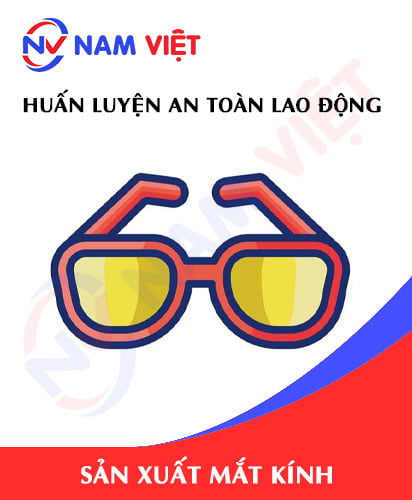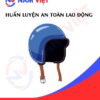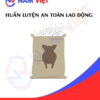Occupational Safety Training for Eyeglass Manufacturing
99,000 ₫
Note: The above price is calculated per person and may vary depending on the number of participants in the course and market fluctuations. For more accurate pricing support, please refer to the price list or contact our consulting staff directly.
Occupational safety is an important issue in eyeglass manufacturing factories and needs to be addressed promptly to ensure the health and safety of workers and enhance the reputation of businesses. The Occupational Safety Training course is one of the effective solutions to raise awareness of accident prevention for workers involved in eyeglass manufacturing.
Table of Contents
Toggle1. Overview of Eyeglasses
a. What are Eyeglasses?
- Eyeglasses are a type of device or material that includes a frame surrounding the eyes and one or two lenses inserted to protect and enhance the wearer’s vision.
- Eyeglasses are used to correct vision problems such as myopia, hyperopia, presbyopia, lazy eye, dry eyes, and glare, and they also protect the eyes from external factors such as strong light, dust, insects, and impact objects. Additionally, eyeglasses are used for decoration and to express the wearer’s style.
- The eyeglass manufacturing industry in Vietnam is currently developing, with many businesses operating in this sector. According to statistics from the General Statistics Office of Vietnam, the production of eyeglasses in 2020 was over 11 million units, an increase of 3.3% compared to the previous year. However, this production only meets approximately 50% of domestic demand, with the remainder imported.

b. Eyeglass Manufacturing Machinery
The machinery used in eyeglass manufacturing includes:
- Glass cutting machines: Use cutting tools with computer-controlled cuts to create glass pieces of the required size and shape.
- Glass grinding machines: Use grinding stones to sand and shape the glass. Machines can be programmed to create different shapes for eyeglass lenses.
- Anti-glare coating machines: Use electrochemical processes to apply an anti-glare film on the lenses. Computers adjust the coating process for precision and contrast.
- Glass milling machines: Use milling tools to remove excess glass and create precise edges.
- Lens measuring machines: Use laser technology to measure lens dimensions and ensure production accuracy.
- Engraving machines: Use lasers to engrave patterns, logos, or letters on the lens surface.
- Glass tempering machines: Use high pressure and temperature to temper the glass, increasing durability and strength.

c. Prominent Eyeglass Manufacturers in Vietnam
Currently, several companies manufacture eyeglasses in Vietnam, including:
- Vietnam Optical Co., Ltd – Việt Optical: One of the leading companies producing and trading eyeglasses in Vietnam, established in 1960, headquartered in Ho Chi Minh City.
- Hanoi Optical Co., Ltd: A pioneer in eyeglass manufacturing and trading in Vietnam, established in 1960, headquartered in Hanoi.
- Ngoc Trinh Eyewear Co., Ltd: A leading company in eyeglass manufacturing and trading in Vietnam, established in 1997, headquartered in Ho Chi Minh City.
- Dong A Eyewear Co., Ltd: A specialized company in manufacturing and trading eyeglasses in Vietnam, established in 1998, headquartered in Ho Chi Minh City.
- Minh Long Eyewear Co., Ltd: A leading eyeglass manufacturer in Vietnam, established in 1997, headquartered in Ho Chi Minh City.
d. Specific Roles in Eyeglass Manufacturing Factories
Group 1
- CEO, Deputy CEO, and department heads in the eyeglass manufacturing factory.
Group 2
- Safety officers: Manage factory safety, design safety procedures, supervise, and ensure employees comply with safe working procedures.
Group 3
- Raw lens production: Use specialized machines to cut, grind, polish, and shape raw glass sheets.
- Anti-reflective coating: Use coating machines to apply reflective film on lens surfaces to reduce glare and enhance aesthetics.
- Scratch-resistant coating: Use coating machines to apply scratch-resistant layers on lenses to increase durability and prevent scratches.
- Cutting lenses into finished products: Use cutting, grinding, and polishing machines to shape and cut lenses into finished products such as eyeglasses, sunglasses, prescription lenses, UV-protection lenses, and frames.
- Quality inspection: Products are inspected using specialized equipment to ensure accuracy and quality.
- Packing and shipping: Products are packed and delivered to distributors and retail stores nationwide.
Group 4
- Office work, support, sales, and marketing.
- Production management, quality management, human resource management, material management, and financial accounting management.
- Research and development of new products, designing product packaging and samples.

2. Overview of Occupational Safety Training for Eyeglass Manufacturing
This article focuses on Group 3 because Group 3 directly participates in production and faces the highest occupational safety risks. For other groups, see here.
a. What is Group 3 Occupational Safety Training?
- Group 3 occupational safety training consists of sessions that raise awareness and teach workers how to prevent occupational accidents.
- The training helps workers recognize hazards and avoid risks to minimize workplace accidents.
REGISTER FOR OCCUPATIONAL SAFETY TRAINING
b. Training Duration
Initial safety training
- Total training duration is at least 24 hours, including assessment time.
- 8 hours of theoretical study on safety policies and labor hygiene laws
- 8 hours of theoretical study on basic occupational safety and hygiene knowledge
- 4 hours of theoretical study on specialized training content
- 2 hours of practical training on specialized content
- 2 hours of theoretical assessment at the end of the course
The safety training center schedules multiple sessions depending on worker availability. Typically, there are 6 sessions over 3 days, provided the manufacturing company allows continuous training.
Periodic safety training
- Before the occupational safety card expires, workers who want reissuance must undergo periodic occupational safety training for at least 50% of the initial training duration.
Explanation: The total periodic occupational safety training duration is at least 12 hours, including assessment time. After completing the course and passing the assessment, workers are reissued and have their occupational safety cards extended.
c. Training Content
| No. | TRAINING CONTENT | TRAINING DURATION (HOURS) | |||
| Total | Including | ||||
| Theory | Practice | Assessment | |||
| I | Safety policies and labor hygiene laws | 8 | 8 | 0 | 0 |
| 1 | Overview of legal documents related to occupational safety and hygiene. | 6 | 6 | ||
| 2 | System of standards and technical regulations on occupational safety and hygiene. | 1 | 1 | ||
| 3 | Specific regulations by state authorities on safety and hygiene when building, expanding, or renovating factories, facilities, or inspecting machinery, equipment, materials, and substances requiring strict occupational safety and hygiene. | 1 | 1 | ||
| II | Basic knowledge of occupational safety and hygiene | 8 | 8 | 0 | 0 |
| 1 | Basic knowledge about hazards and harmful factors in the workplace. | 4 | 4 | ||
| 2 | Methods to improve working conditions. | 1 | 1 | ||
| 3 | Safety culture in production and business. | 1 | 1 | ||
| 4 | Rights and obligations of employers and employees; policies on occupational safety and hygiene; roles and duties of safety networks and officers. | 1 | 1 | ||
| 5 | Occupational safety rules, signs, safety equipment, personal protective equipment; basic first aid and prevention of occupational diseases. | 1 | 1 | ||
| III | Specialized training content | 6 | 4 | 2 | 0 |
| Comprehensive knowledge of machinery, equipment, and hazardous substances; risk analysis, assessment, and management; safe working procedures with machinery and substances requiring strict occupational safety and hygiene. | 6 | 4 | 2 | ||
| IV | End-of-course safety training assessment | 2 | 2 | 0 | 0 |
| Total | 24 | 22 | 2 | ||
See more training content for all 6 groups
d. Occupational Safety Card
After completing occupational safety training and passing the assessment, workers will be issued a occupational safety card (commonly called Group 3 safety certificate).
The Group 3 safety card displays information such as full name, date of birth, specific job and working environment, training duration, official seal, and signature confirming completion.
According to regulations on card issuance specified in Clause 2 of Article 24, Decree 44/2016/ND-CP, there are two cases:
- If the employer and employee have a labor contract, the employer must sign, stamp, and certify the Group 3 occupational safety card after the worker completes the training and passes the assessment.
- If the worker is freelance or seasonal and does not have a labor contract, the training unit must sign, stamp, and certify the card after the worker completes the training and passes the assessment.

3. Identifying Hazards Affecting Workers in Eyeglass Manufacturing
Some hazards affecting workers during eyeglass manufacturing may include:
- Risk of eye injury may occur during the eyeglass production process, especially when cutting, grinding, and polishing lenses. To prevent this risk, workers should use protective glasses, enhance occupational safety training, and comply with safety procedures.
- The eyeglass production process may involve the use of chemicals and hazardous materials such as acids, solvents, and adhesives. Direct contact with these substances can cause skin burns or chemical burns. To ensure safety, workers need to use full protective equipment and follow safety procedures during work.
- Machinery and equipment used in eyeglass production can cause occupational accidents if not used properly or maintained regularly. To avoid accidents, workers should be trained in the use of machinery, maintenance, and periodic equipment servicing.
- The eyeglass manufacturing process may generate dust and toxic fumes. Inhaling this dust and fumes over long periods can be harmful to workers’ health. To ensure safety, it is necessary to use full protective equipment, especially dust and chemical-resistant masks.
4. Common Occupational Accidents in Eyeglass Manufacturing
Some common occupational accidents during eyeglass manufacturing include:
- Cuts, tears, or punctures to hands from cutting blades, knives, sharp materials, or rough raw materials.
- Eye and skin damage due to strong light from glass processing machines, lighting, or fine dust during polishing.
- Hearing loss due to loud noise from machinery.
- Chemical poisoning from exposure to chemicals such as solvents, dyes, cleaning agents, and opacifying agents.
- Slips and falls due to wet floors or moving in confined spaces.
- Injuries from heavy objects, collisions with machines, or equipment.
- Mental health issues, stress, and psychological pressure.
5. Safety Measures When Participating in Eyeglass Manufacturing
Safety measures when participating in eyeglass manufacturing include:
- When working in an eyeglass manufacturing factory, workers should use personal protective equipment such as safety glasses, gloves, masks, helmets, and anti-puncture shoes to ensure body safety.
- Eyeglass manufacturing machinery should be regularly inspected to ensure safety and product quality. Additionally, electrical lines, piping systems, and mechanical systems must be properly maintained and repaired.
- Employees working in the eyeglass factory need training on safety regulations and procedures, how to use personal protective equipment, and emergency measures in case of incidents.
- During eyeglass production, safe and compliant materials should be used to ensure product safety. Materials must also be stored properly and free from contamination.
- Eyeglass production often involves chemicals and high temperatures, so fire and explosion prevention measures should be implemented, including occupational hygiene, regular inspection of fire-fighting systems, and identifying hazardous areas.
- Factories must comply with labor safety, environmental protection, and product quality regulations.
- Regularly conduct occupational environment monitoring in the factory to collect and analyze harmful factors affecting workers, thereby reducing risks and preventing occupational diseases.

6. Benefits of Occupational Safety Training in Eyeglass Manufacturing
An Toan Nam Viet provides your business with the following benefits after completing occupational safety training courses according to Decree 44/2016/ND-CP on Occupational Safety and Hygiene:
- Workers can identify potential occupational hazards and take preventive measures to avoid accidents.
- Your company can establish risk prevention measures in production, operation, and maintenance processes.
- Minimizes costs associated with occupational safety risks.
- Continuous production without interruptions increases labor productivity and product quality.
- Ensures compliance with labor safety regulations, avoiding legal risks.
- Enhances professionalism and credibility, thereby elevating the company’s brand image.
Nam Viet’s training courses are designed to prevent external risks to individuals, helping them avoid dangers that could result in injury or, in severe cases, death.
REGISTER FOR OCCUPATIONAL SAFETY TRAINING SERVICE
7. Customer Feedback After Completing Eyeglass Manufacturing Safety Training
An Toan Nam Viet has years of experience supporting many businesses in Vietnam, especially in the southern provinces. This responsibility is highly valued, which is why our Occupational Safety Training is increasingly professional. The motivation behind An Toan Nam Viet’s growth comes from positive feedback and suggestions from our clients. Below are testimonials from the partners we have served.
See more customer interviews after using the service of An Toan Nam Viet
8. An Toan Nam Viet’s Occupational Safety Training Capabilities
An Toan Nam Viet is a reputable and high-quality occupational safety training center in Vietnam. Our training sessions are continuously conducted at factories, production workshops, or construction sites across the country (all 63 provinces of Vietnam).
REGISTER FOR OCCUPATIONAL SAFETY TRAINING SERVICE
Occupational Safety Training License
- An Toan Nam Viet has been inspected and certified by the Department of Labor Safety under the Ministry of Labor – Invalids and Social Affairs and received a certificate of eligibility for occupational safety and hygiene training. This further strengthens our capability in occupational safety training.

Training Materials and Lectures
- Before occupational safety training materials are used in safety training courses, they are reviewed and approved to ensure accuracy and effectiveness when applied.
- Teaching methods are standardized according to An Toan Nam Viet guidelines, developed by experts in occupational safety and hygiene training to maximize knowledge retention for learners.
Facilities
- Controlling classroom conditions during training improves teaching efficiency and knowledge retention.
- Our training facilities provide spacious classrooms meeting standards for area, lighting, training equipment, etc.
9. National Reputable Occupational Safety Training Center
At An Toan Nam Viet, we prioritize the professional commitment to occupational safety training. Teaching workers to protect themselves equips them with essential safety skills, contributing to national development.
To ensure effective training, every detail is carefully prepared, from tools, teaching equipment, curricula, documents, to sound and lighting systems.
Our instructors are experienced experts, some with research work identifying hazards across industries and methods to prevent them.
Lectures are practical, vivid, and easily understood by workers, ensuring a comfortable learning environment and effective knowledge absorption. All knowledge aligns strictly with Decree 44/2016/ND-CP.
This enables learners to understand hazard prevention measures and self-protection, applying them appropriately in real work situations.
Our training center prides itself on providing professional, reliable occupational safety training with advantages such as:
- Competitive training costs while maintaining high-quality standards.
- Flexible training schedule to accommodate the company’s production needs.
- Quick and compliant certification procedures in accordance with the law.
- Experienced instructors with many years in the field.
- Controlled classroom conditions to maximize teaching efficiency and knowledge retention.
- Lectures tailored to occupational safety practices in enterprises.
- Dedicated and professional service to provide accurate and timely support to clients.

10. Additional References for Eyeglass Manufacturing Safety Training
- Eyeglass Manufacturing Occupational Safety Materials (glasses)
- Occupational Safety Training Material Set
- Occupational Safety Training Test Set
- Eyeglass Manufacturing Safety Training Multiple-Choice Test (glasses)
- Eyeglass Manufacturing Safety Training Slides (glasses)
1 review for Occupational Safety Training for Eyeglass Manufacturing
No comments yet















namchinh.haiphong341
Dịch vụ huấn luyện an toàn lao động rất tốt nhé!